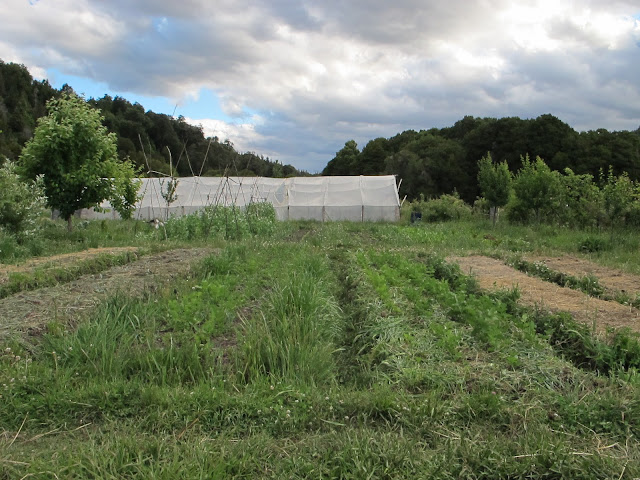 |
| A view of the southern end of the valley Azul |
 |
| Granja Valle Pintado. The community kitchen on the left, garden in the center, and grain field to the right. |
 |
| Further up the valley. Our farm is the little green patch furthest to the right. |
This week I had a chance to hike around a bit. I spent yesterday afternoon exploring the umarked network of trails on the eastern ridge. I found some beautiful views of the valley and a wild cherry tree full of sweet ripe fruit! There´s a lot more to explore. Just a few kms up river from us a fork of the Azul turns up a steep gorge towards Hielo Azul, the glacier at it´s head waters. Further south the river empties into Lago Puelo, a beautiful lake sitting on the Argentine Chilean border. I´ll explore both in the next few weeks.
It´s been a busy week on the farm. I´ve been focusing on pest managment, and construction of the new invernadero (greenhouse). Aphids are starting to show up in our brasillicas, and pilmes are reaking havoc in the favas and potatos. We don´t use any chemicals on the farm, so our pest managment strategies involve strategies like not weeding in well established beds to create pest habitat, and hand removal. When we make sweeps through a bed to remove pests, we dump them in a bottle containing water and a little bit of oil. We leave the bottles full of the pests near hot spots. Within a few days it begins to ferment and the bugs clear out. Usually u can protect a 10-15 meter radius with one well filled bottle. Other strategies are the use of ash, crushed eggshells, and fermented herb solutions. Every pest/plant combo requires a unique solution.
I´ve been reading a lot since I´ve been here. I just finished One Straw Revolution by Mirukami Fukouka, the Japanese farmer famous for achieving very high yeilds with a very passive approach. He talks a lot about the infiriority of human developed systems in comparison with the complexity of nature, pointing out the inherent instability of a cultivated ecosystem and the many advantages of farming methods with mimic natural ecosystems and allow plants to follow thier natural form or life cycle as closely as possible. Some pretty interesting points. My favorite being "the farmers greatest tool is observation". I´ve also been reading about how to hatch and raise a new batch of chickens. We´ve started to allow eggs to stack up in a few nests to stimulate brooding. We aim to hatch 60, hoping to raise 30-40 new hens, and harvest about half of our current flock. Yum!!!
Another thing that has really peaked my interest is fermentation! I´ve been reading a couple of books on culturing, brewing and other fermentation processes (Wild Fermentation: The Flavor, Nutrition, and Craft of Live-Culture Foods by Sandor Elix Katz, and Sacred and Herbal Healing Beers: The Secrets of Ancient Fermentation by Stephen Buhner). Did you know humans were making a primitive form of mead (fermented honey and water) well before we´d figured out how to manage fire!? The world of fermentation is super interesting! I love the idea of using all sorts of tiny creatures to render unique artisan brews, breads, preserves, cheeses, and other things. Fermented food posses some amazing probiotic properties, and are really darn good. I´ve already had a chance to help with brewing some lemon rose-hip wine, an IPA pale ale (the locals pronouce it "eepah pawleh awleh"), and some ginger ale. I have also started keeping kefir! I´ve had some experience with a different form of kefir in the past that eats milk and renders a yogurt-like superfood. This is a different kind though. This sort of kefir eats a sugar water solution, and creates a slightly carbonated, very refreshing, and nutritious drink. I am maintaining two jars at the moment. I´ve added slices of oranges and peaches for flavoring in the large one. Lemon, mint and sage in the smaller. We drink a bit every couple of days and refill the jars with fresh agua y azucar integral. It´s very simple.¡Y que rico!
 |
| My Kefir expierement! |















